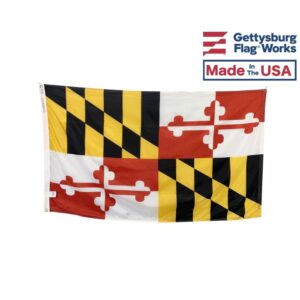Maryland’s crowded flag
By James Breig

Charles I of Great Britain granted Maryland’s charter in 1632 and assigned it to Lord Baltimore (Cecilius Calvert). The king’s command was “to transport an ample Colony of the English Nation unto a certaine Countrey…in the parts of America not yet cultivated and planted.” Maryland was named for Charles’ wife, Henrietta Maria.
Successive Lord Baltimores would hold sway over the new colony as royal governors, so it is no surprise that the Maryland flag would derive in part from the Calvert crest, making it the only state flag drawn from British heraldry. Another family is also represented on the flag: the Crosslands. They were the ancestors of the mother of George Calvert, the first Lord Baltimore.
The Calvert crest, colored black and gold, resembles a distorted checkerboard; the Crossland crest is red and white with “a cross bottony.”
During the Civil War, a time of national division, supporters of the Union waved the Calvert flag, while secessionists opted for the Crossland crest. After the war ended, Marylanders began joining the two flags as a symbol of their reunion.
The combined banner was not officially adopted as the state flag until 1904 – 272 years after King Charles granted the land to the Calverts. A 1904 Maryland newspaper article remarked that the flag seemed to “have been adopted by common consent.”
Under an unusual – perhaps unique — state law that governs flagpoles, “any ornament affixed to the top of a flagstaff carrying the Maryland flag…must be a gold cross bottony (Botonee).”
Two mentions of “bottony” demand a clarification. The word doesn’t mean the study of flowers. A bottony is a cross with a trefoil design on the end of each arm. The word derives from a French term meaning “covered with buds.”
